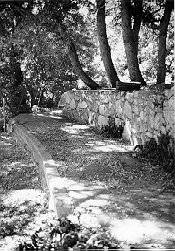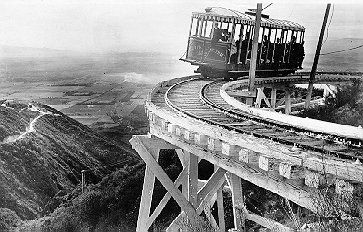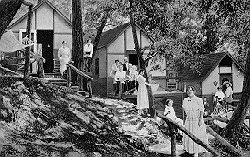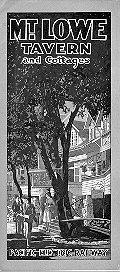
A Visit To Alpine Tavern
By Jake Brouwer
 A visit to Alpine
Tavern is nothing like it used to be ‘cept for the feeling
you get when you arrive. By foot it’s a long haul from the
metropolis below and a welcome place to rest your weary bones in
the shade of the grand old oaks and pines that surround the
vicinity. If you arrive via the upper trails it’s a
three-mile hike to the tavern site and it still warmly receives
any fatigued visitor. The Mt. Lowe Trail Campground now occupies
the site of the famous Alpine Tavern, a fine spot to camp or rest
as you traverse the trails by foot or mountain bike.
A visit to Alpine
Tavern is nothing like it used to be ‘cept for the feeling
you get when you arrive. By foot it’s a long haul from the
metropolis below and a welcome place to rest your weary bones in
the shade of the grand old oaks and pines that surround the
vicinity. If you arrive via the upper trails it’s a
three-mile hike to the tavern site and it still warmly receives
any fatigued visitor. The Mt. Lowe Trail Campground now occupies
the site of the famous Alpine Tavern, a fine spot to camp or rest
as you traverse the trails by foot or mountain bike.
Of course it wasn’t always that way. For nearly forty-one years folks had the opportunity to ride the electric rails from Echo Mountain to Ye Alpine Tavern.
 After the hair-lifting journey up the incline folks
would settle back in their seats to enjoy the ride, for what
could be more thrilling than the incline? They would find that
out soon enough as the trolley wound round the curves of Las
Flores Canyon, crossing trestles that looked flimsy from a
distance, like a spider’s finely spun
thread. Alternating emotions of happiness and horror, ecstasy and
dread as the trolley passed perpendicular cliffs and then, what
is this? CIRCULAR BRIDGE? "Oh no, what have we gotten
ourselves into" passengers might have thought to themselves.
Looking over what appeared to be a 2500-foot precipice the rider
on the outside seat might even have had a "white
knuckle" experience before reaching the other side of the
bridge.
After the hair-lifting journey up the incline folks
would settle back in their seats to enjoy the ride, for what
could be more thrilling than the incline? They would find that
out soon enough as the trolley wound round the curves of Las
Flores Canyon, crossing trestles that looked flimsy from a
distance, like a spider’s finely spun
thread. Alternating emotions of happiness and horror, ecstasy and
dread as the trolley passed perpendicular cliffs and then, what
is this? CIRCULAR BRIDGE? "Oh no, what have we gotten
ourselves into" passengers might have thought to themselves.
Looking over what appeared to be a 2500-foot precipice the rider
on the outside seat might even have had a "white
knuckle" experience before reaching the other side of the
bridge.
Then came Devils Slide and Devils Gate and according to the brochures, surely this was THE thrill ride of the day. Finally while the conductors spiel told of the points of interest ahead, the traveler rounded the last turn and the ride ended in front of Ye Alpine Tavern.
 What
was needed next was a spot in front of the grand old fireplace
and some restorative food. Ah, safe at last! Of course not all
riders on the Scenic Mt. Lowe Railroad were fainthearted, but
they all did enjoy the opportunity to stop and rest amongst the
twisted oaks.
What
was needed next was a spot in front of the grand old fireplace
and some restorative food. Ah, safe at last! Of course not all
riders on the Scenic Mt. Lowe Railroad were fainthearted, but
they all did enjoy the opportunity to stop and rest amongst the
twisted oaks.
What a concept it was, to travel from the beaches in the morn at Santa Monica Bay and then on through groves of oranges and finally on up to a fine mountain chalet, and all in a day! So, it was no wonder that at the end of a long day a place to rest would be most desirable.
Ye Alpine Tavern came to be as a result Professor Thaddeus Lowe’s difficulties in raising the money needed to finish the Alpine Division of his railroad. Original estimates by the California Construction Company were $200,000.
Unfortunately 1895 was not the best of economic times. Lowe already mortgaged his beautiful home and Grand Opera House to raise money. Then he came up with various revenue raising schemes, hoping the publicity and the funds raised would get him through.
One idea was to bottle and deliver to the masses below, pure Crystal Springs water. An advertisement from the time said, "This water issues from solid granite rock, 5,000 feet above sea level, on the west slope of Mount Lowe.
Another scheme was to pick up passengers in Tally-ho coaches, and deliver them to Altadena Junction in first class style.
At last an idea was formed that brought in some money, the Alpine Club. The Alpine Club was to be for the benefit of professional and businessmen of the area. Lowe figured if each member would purchase ten shares of stock at $100.00 each, he would only need 100 members to reach his desired goals. Instead of paying interest, the members received transportation and hotel accommodations amounting to 10% of their investment.
 The
clubhouse was built at Crystal Springs, which became the terminus
for the Alpine Division of the railroad. Only thirty or so
memberships were purchased, but that was more than enough to
build what was to be known as Ye Alpine Tavern.
The
clubhouse was built at Crystal Springs, which became the terminus
for the Alpine Division of the railroad. Only thirty or so
memberships were purchased, but that was more than enough to
build what was to be known as Ye Alpine Tavern.
The architect for the job was Louis F. Kwiatkowski, who also was involved with the remodeling plans for Lowe’s Opera House. This original design was constructed with blocks of granite and Oregon pine finished in the natural color of the wood. The granite blocks of the foundation would reach up to the windows of the first floor.
 The building measured 40 X 80
feet with the main floor used for dining purposes. It vast room
would seat over two hundred people. In the dining room were five
fireplaces, the main one being twelve feet from side to side and
seven feet tall. In each of it’s corner were stone blocks
for seats. Above this grand fireplace hung a massive oak beam
which had the saying, "YE ORNAMENT OF A HOUSE IS YE GUEST
WHO DOTH FREQUENT IT", carved into it. On one side was an
old-fashioned brick oven and on the other side an opening where
"mystery" and other fluids are kept for the people of
Pasadena.
The building measured 40 X 80
feet with the main floor used for dining purposes. It vast room
would seat over two hundred people. In the dining room were five
fireplaces, the main one being twelve feet from side to side and
seven feet tall. In each of it’s corner were stone blocks
for seats. Above this grand fireplace hung a massive oak beam
which had the saying, "YE ORNAMENT OF A HOUSE IS YE GUEST
WHO DOTH FREQUENT IT", carved into it. On one side was an
old-fashioned brick oven and on the other side an opening where
"mystery" and other fluids are kept for the people of
Pasadena.
The water from Crystal springs became the water supply for the hotel, furnishing not only pure water for drinking and bathing but also for heating. In the winter months most guests would prefer the amenities of the tavern, while for the summer Lowe planned to build cottages.
On September 26, 1895 Thaddeus Lowe invited the entire Pasadena Chamber of Commerce, newspaper people, administrators of prominent colleges, and others loyal to his cause, for the opening ceremonies of Ye Alpine Tavern. The grand event that was planned to win back the city of Pasadena was held on December 14, 1895. It was a huge success for the Professor who was the recipient of many toasts and testimonials.
Unfortunately bad financial times for the professor brought the railroad into receivership and in 1897 J. Sidney Torrance was made sole receiver by the courts.
This was not such a bad thing for Ye Alpine Tavern, for under the prior management the hotel had fallen into less than desirable condition. Torrance felt that the tavern needed to accommodate a greater amount of people and set forth enlarging the hotel. A new 70 X 30 dance hall was added to the east end of the building where an orchestra played most every day during the summer and weekend and holidays during the rest of the year.
 Fares were lowered to $2.50 for a round trip visit.
Finally the railroad was made available to the masses instead of
just the wealthy. At Ye Alpine Tavern, Torrance had cottages
built along the ravines. Traffic to the tavern started increasing
and a third observation car was added to the Alpine Division.
Fares were lowered to $2.50 for a round trip visit.
Finally the railroad was made available to the masses instead of
just the wealthy. At Ye Alpine Tavern, Torrance had cottages
built along the ravines. Traffic to the tavern started increasing
and a third observation car was added to the Alpine Division.
By 1902 Henry Huntington had acquired the holdings of the Pasadena and Mt. Lowe Railroad as well as the Los Angeles and Pasadena Railroad. The Pacific Electric Railroad was organized and ran the railroad on Mt Lowe until its demise in 1936.
 Due to
the loss of buildings because of fires and windstorms, Echo
Mountain soon became a mere transfer point for folks on the way
to Ye Alpine Tavern. Modest alterations in the building were done
as the years rolled on. A porch here, a coat of paint there, but
in April of 1925, ceremonies were held at the tavern to celebrate
the finishing of what is known as the concrete annex. This annex
added thirty-one rooms bringing the capacity of the hotel up to
one hundred-eighty-five.
Due to
the loss of buildings because of fires and windstorms, Echo
Mountain soon became a mere transfer point for folks on the way
to Ye Alpine Tavern. Modest alterations in the building were done
as the years rolled on. A porch here, a coat of paint there, but
in April of 1925, ceremonies were held at the tavern to celebrate
the finishing of what is known as the concrete annex. This annex
added thirty-one rooms bringing the capacity of the hotel up to
one hundred-eighty-five.
At this time the name of the tavern was changed to Mt. Lowe Tavern. The grand Swiss styled structure at the terminus of the railway had been successfully transformed into a hotel with the most modern of amenities. New handsome furniture adorned the rooms while the rockers by the great fireplace now took on an upholstered leather look. Rooms had hot and cold running water and private baths. For those wishing to keep in touch with friends back home, long distance telephones were provided, as well as two mailings a day for the Mt. Lowe Post Office. Daily newspapers were delivered as well as the Mt. Lowe Daily News, which had its offices at the tavern.
 The cottages were also upgraded. There were now some
forty cottages and one six room bungalow. Some were housekeeping
cottages, for those who wanted the rustic of the mountains. These
tent cottages had gas stoves and kitchens equipped to cook any
meal. A shoppe on the main floor of the hotel supplied food.
There was a change of linen weekly and a change of towels daily.
Tables had oilcloth covers and for a nominal charge napkins and
paper tablecloths could be obtained at the store. Shower bathes
were free, but hot bathes were thirty-five cents. Patrons could
use the laundry free and then rent an electric iron for fifteen
cents.
The cottages were also upgraded. There were now some
forty cottages and one six room bungalow. Some were housekeeping
cottages, for those who wanted the rustic of the mountains. These
tent cottages had gas stoves and kitchens equipped to cook any
meal. A shoppe on the main floor of the hotel supplied food.
There was a change of linen weekly and a change of towels daily.
Tables had oilcloth covers and for a nominal charge napkins and
paper tablecloths could be obtained at the store. Shower bathes
were free, but hot bathes were thirty-five cents. Patrons could
use the laundry free and then rent an electric iron for fifteen
cents.
The hotel dining room was famed for its fresh meats, fruits and vegetables. Choice wines and liquors were available for those that desired them.
 Billiards, dancing, tennis and other amusements
were provided free for the hotel guests as well as guests in the
cottages. A circulating library kept the readers in the group
busy evenings while others might have listened to the phonograph
in the music room.
Billiards, dancing, tennis and other amusements
were provided free for the hotel guests as well as guests in the
cottages. A circulating library kept the readers in the group
busy evenings while others might have listened to the phonograph
in the music room.
Perhaps my favorite spot in the hotel would have been the souvenir stand near the lobby. Here a guest could purchase a postcard to send along to a friend or perhaps a sterling silver souvenir spoon. Charles Lawrence also took many fine photographs of the mountain resort, which were for sale there.
From the tavern innumerable scenic trails led in all directions. The closest trip was to Inspiration Point, just one half mile away. From here one could view up to 56 cities and the island of Catalina. A small railroad started at Inspiration Point called the OM& M, which stood for one man and a mule. I t was run by a man named Zetterwall who lived at the tavern.
 During the depression the number of round trips on the
line were dropped and the prices reduced to $1.00. For $4.50 you
could get a room, two meals and the round trip.
During the depression the number of round trips on the
line were dropped and the prices reduced to $1.00. For $4.50 you
could get a room, two meals and the round trip.
By 1935 the OM & M was shutdown and the searchlight was put out.
On September 15th 1936 a fire broke out in the hotel during the evening destroying nearly everything. Over 100 people helped to fight the fire and no one was hurt.
In 1941 the property at the tavern was sold to the government and became part of the Angeles National Forest.
March of 1959 the shell of the annex building was dynamited along with the great fireplace and the foundations of the old hotel.
 |
Send email to Echowebmaster@aaaim.com to report any problems.
Last modified: February 12, 1999
No part of this paper may be
reproduced in any form without written permission from:
Jake Brouwer
All articles and photos were provided by:
Land-Sea Discovery Group
Copyright © 1999